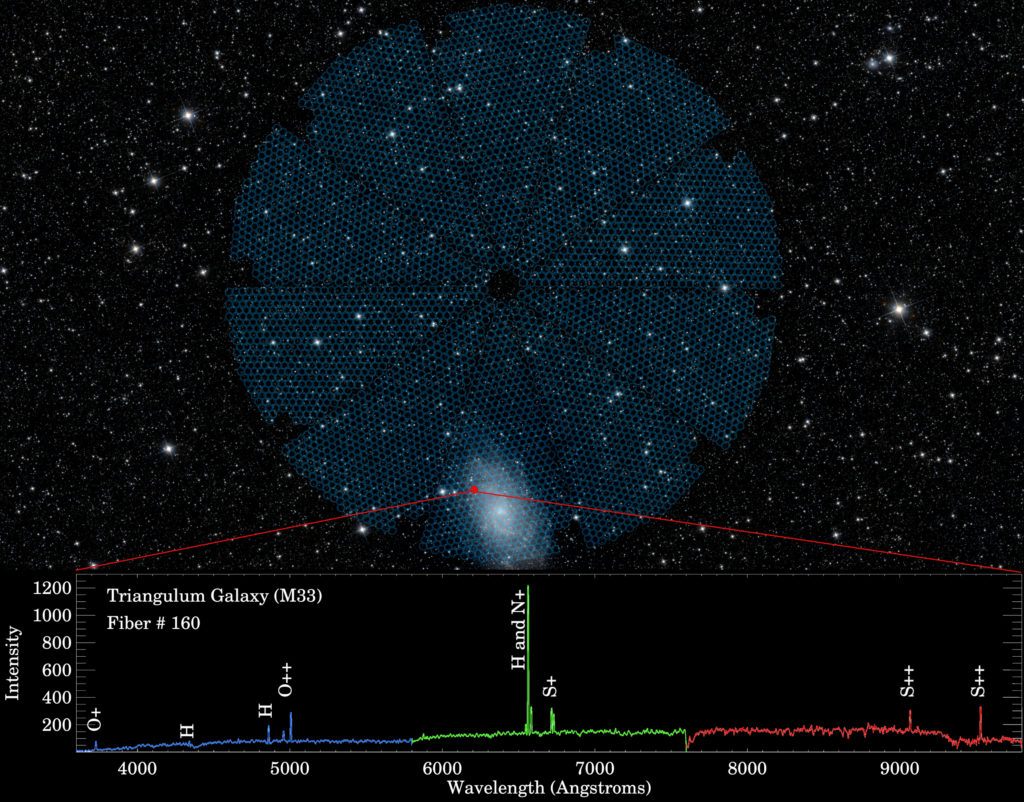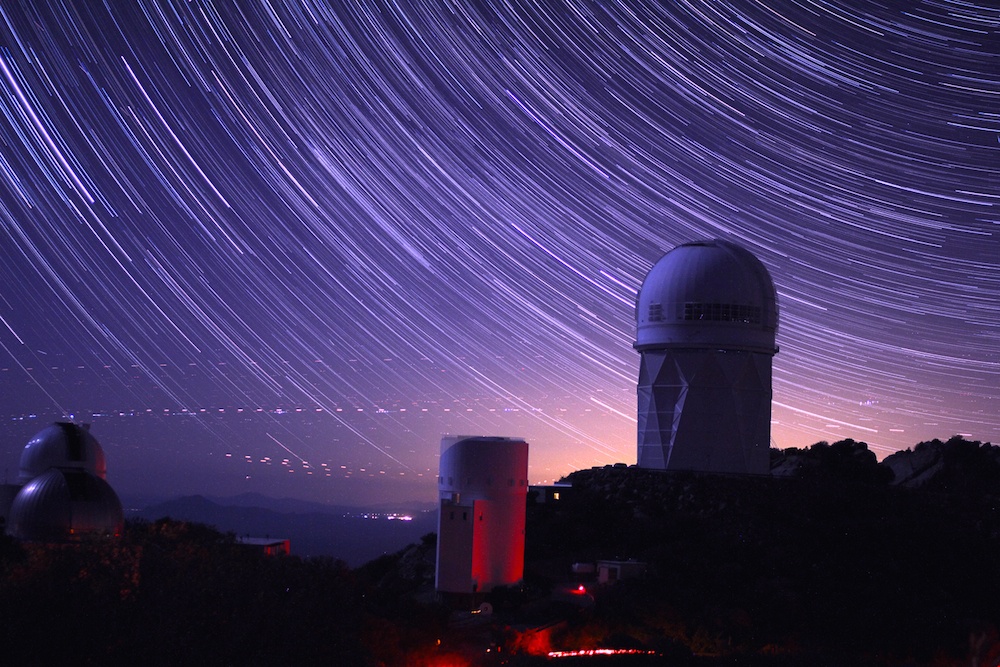A new instrument mounted atop a telescope in Arizona has aimed its robotic array of 5,000 fibre-optic “eyes” at the night sky to capture the first images showing its unique view of galactic light.
It was the first test of the Dark Energy Spectroscopic Instrument, known as DESI. The long-awaited instrument is designed to explore the mystery of dark energy, which makes up about 68 percent of the universe and is speeding up its expansion.
The DESI collaboration includes nearly 500 researchers at 75 institutions in 13 countries, including Perimeter Computational Scientist Dustin Lang and Associate Faculty member Will Percival (who is also a Distinguished Research Chair in Astrophysics at the University of Waterloo and Director of the newly launched Waterloo Centre for Astrophysics).
DESI’s components are designed to automatically point at preselected sets of galaxies using 5,000 robotic positioners that swivel in a choreographed dance. They use light-gathering fibre-optic cables to collect each galaxy’s light, and then split that light into thousands of colour bands using spectrographs designed to measure redshift (which is the shift in the colour of objects to longer, redder wavelengths as an object moves away from us). DESI scientists can then gauge how much the universe expanded as the light traveled to Earth – and thereby precisely map the galaxy’s distance from Earth.
The DESI robotic positioners can be moved to collect light from a new set of 5,000 galaxies in a matter of minutes, an unprecedented surveying speed that will allow it to build maps over 20 times faster than any predecessor experiment.
Of course, in order to point this powerful instrument at preselected sets of galaxies, one must first select which galaxies to aim it at. That’s where Dustin Lang comes in.
Since 2014, Lang has been working with a team of astronomers to carry out an extensive sky-mapping campaign. The team spent more than 1,000 nights at three different telescopes in Arizona and Chile to observe one-third of the sky – specifically, the one-third most visible from DESI’s location at Kitt Peak National Observatory near Tucson, Arizona. These observations were done using three different-coloured filters, to greater sensitivity than is available in any existing sky surveys.
Based on the observations, the team produced two-dimensional images of the faint galaxies that DESI will observe. The images were then transferred to the supercomputers at the US Department of Energy’s National Energy Research Scientific Computing Center, where the team developed software to calibrate the images, and detect and measure the stars and galaxies in them. These measurements of the shapes and colours of galaxies are being used to decide which stars and galaxies are likely to fall within the distance range that DESI wants to measure.
“In total, we measured over a billion stars and galaxies, and we get to choose 35 million of them for follow-up with DESI,” explains Lang. “It’s really exciting that DESI is now going to be observing the galaxies that we measured. While 35 million galaxies is only a small fraction of the total detected, it is still a huge leap ahead of the largest survey to date, the Sloan Digital Sky Survey, which has collected about 3 million galaxy spectra in over 10 years of observations.”
Meanwhile, Will Percival has been preparing for the science to come from the survey. For the last three years, he has been a co-lead of the collaboration’s working group dedicated to developing the techniques required to extract the cosmological signal from galaxy clustering within the DESI data.
“The DESI data represents such a leap forward in size and quality compared to previous galaxy surveys that we have had to develop many new methods for their analysis,” says Percival. “And with DESI’s final testing underway and the formal start of observations expected in early 2020, we’re all going to be busier and busier from now on.”
By mapping the distance to 35 million galaxies and 2.4 million quasars across one-third of the area of the sky, DESI will shed light on the mystery of dark energy. Over a five-year run, the new instrument will peer deeply into the universe’s infancy – up to about 11 billion years ago – allowing us to make very precise measurements of the universe’s expansion rate. Gravity had slowed this rate of expansion in the early universe, but dark energy has sped it up.
“Most of the universe’s matter and energy are dark and unknown, and next-generation experiments like DESI are our best bet for unraveling these mysteries,” said DESI Director Michael Levi of the Department of Energy’s Lawrence Berkeley National Laboratory, the lead institution for DESI’s construction and operations. “I am thrilled to see this new experiment come to life.”
Installation of DESI began in February 2018 at the Nicholas U. Mayall Telescope at Kitt Peak National Observatory. Its first test took place on October 22, 2019, marking the culmination of a decade of planning, research and development, installation, and assembly. For more details on how it came together, refer to the official press release.
– With files from Berkeley Lab
Further exploration
About PI
Perimeter Institute is the world’s largest research hub devoted to theoretical physics. The independent Institute was founded in 1999 to foster breakthroughs in the fundamental understanding of our universe, from the smallest particles to the entire cosmos. Research at Perimeter is motivated by the understanding that fundamental science advances human knowledge and catalyzes innovation, and that today’s theoretical physics is tomorrow’s technology. Located in the Region of Waterloo, the not-for-profit Institute is a unique public-private endeavour, including the Governments of Ontario and Canada, that enables cutting-edge research, trains the next generation of scientific pioneers, and shares the power of physics through award-winning educational outreach and public engagement.
You might be interested in


Spiralling light from M87’s supermassive black hole reveals strong magnetic fields
November 8, 2023


